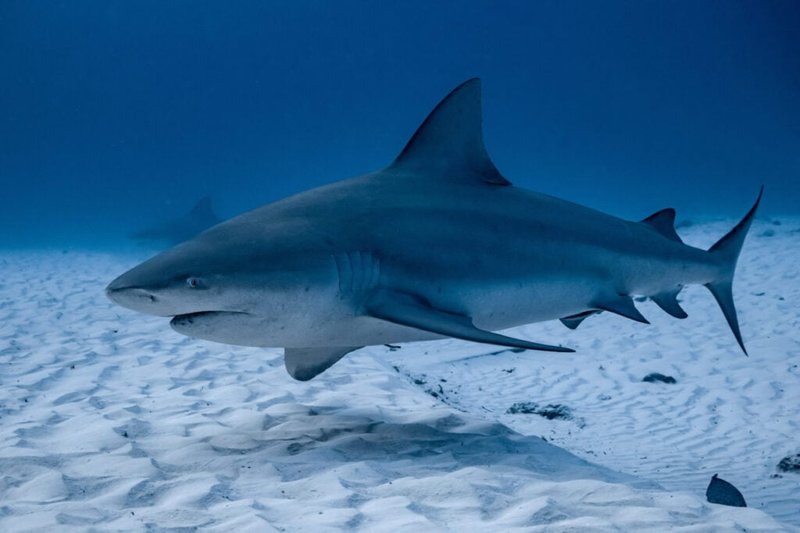
The Bull Shark is one of nature’s most fascinating creatures. Known for its distinctive, stocky build and aggressive reputation, this species is often found in both salt and freshwater. Imagine it as the rugged, no-nonsense swimmer of the ocean—broad, powerful, and always ready for anything. This impressive shark can thrive in rivers and lakes, which sets it apart from many of its ocean-dwelling relatives.
What makes the Bull Shark truly unique is its adaptability. Unlike many sharks that prefer the open ocean, Bull Sharks have a knack for navigating shallow waters, making them frequent visitors to estuaries and coastal areas. You might even spot one in a river, far from the ocean, which can come as a surprise to those unfamiliar with their tendencies. Let’s dive deeper into the world of the Bull Shark and uncover what makes it such an intriguing species.
Physical Characteristics of Bull Sharks
Bull Sharks are known for their broad, flat snouts and robust bodies. They typically grow between 7 to 11.5 feet in length, with females often being larger than males. Their skin is a grayish color, darkening towards the top and lightening on the underside, a pattern known as countershading. This coloring helps them blend into their surroundings, making it easier for them to ambush prey. Imagine a stealthy predator camouflaged against the sandy ocean floor.
What’s striking about the Bull Shark is its muscular build. These sharks are built like tanks, which allows them to swim powerfully and with agility. You might picture them cutting through the water with a strength that can be intimidating. They have strong jaws filled with sharp teeth that can easily tear through flesh—an essential tool for hunting. Their unique anatomy also includes special adaptations that allow them to tolerate freshwater, which is unusual for most sharks.
Habitat and Distribution
Bull Sharks are incredibly versatile in their habitat choices. They can be found in warm coastal waters globally, from the Atlantic Ocean to the Indian Ocean. They often inhabit shallow waters near shorelines, making them a favorite among anglers. One fascinating aspect is their ability to swim upriver, reaching places like the Mississippi River and Lake Nicaragua. This adaptability to both saltwater and freshwater highlights their unique ecological niche.
Typically, Bull Sharks prefer areas near estuaries and river mouths where salt and freshwater mix. This habitat is rich in nutrients and supports a variety of prey. Think of it as a buffet for the Bull Shark, where they can feast on fish, dolphins, and even birds. Their preference for shallower waters often places them in close proximity to human activities, which can sometimes lead to encounters—or misunderstandings, as some people fear them unduly.
Diet and Hunting Behavior
The diet of a Bull Shark is as diverse as their habitat. They are opportunistic feeders, meaning they’ll eat whatever is available. Their menu can include fish, crustaceans, and smaller rays, but they don’t shy away from larger prey if the opportunity presents itself. Think of them as the vacuum cleaners of the ocean, ready to chomp down anything that comes their way.
When it comes to hunting, Bull Sharks employ a variety of strategies. They are known to use surprise attacks, often ambushing their prey from below. This hunting style is a testament to their speed and agility. Picture a football player weaving through defenders—Bull Sharks have that same kind of finesse when moving through water. Their heightened sense of smell allows them to detect prey from miles away, making them formidable hunters.
Behavior and Social Structure
Bull Sharks are generally solitary creatures but can sometimes be seen in groups, especially in areas with abundant food. They are known for their aggressive behavior, which is often misunderstood as purely territorial. In reality, they are simply responding to their environment and the availability of resources. You might be surprised to learn that young Bull Sharks are often more social, forming nursery groups for protection against larger predators.
Understanding their social dynamics can be tricky. Most of the time, these sharks prefer their own company. However, when the circumstances are right—like during breeding seasons or in favorable feeding grounds—they might gather together. It’s nature’s way of optimizing survival and ensuring that the species continues to thrive.
Reproduction and Lifespan
Bull Sharks are viviparous, meaning they give birth to live young instead of laying eggs. The gestation period lasts about 10 to 11 months, after which a female can give birth to anywhere from 1 to 13 pups. Imagine a momma Shark, nurturing her tiny pups in the safety of shallow waters before they venture into the big ocean. This care is crucial, especially since the pups are vulnerable to larger predators, including their own kind.
In terms of lifespan, Bull Sharks can live up to 16 years in the wild, though some individuals may reach 30 years. Their life cycle can be influenced by environmental factors and human activity. You might find it interesting that, due to their adaptability, Bull Sharks can thrive in various conditions, which often aids in their longevity despite the dangers they face.
Conservation Status
The conservation status of Bull Sharks is a concern for marine biologists and conservationists alike. While they are not currently considered endangered, their populations are threatened by overfishing, habitat loss, and pollution. Like many shark species, they play a crucial role in maintaining the health of marine ecosystems. Losing them could disrupt the balance within their habitats, leading to wider environmental impacts.
Efforts are being made around the globe to protect Bull Sharks and their habitats. Marine protected areas, stricter fishing regulations, and public awareness campaigns are vital. Think of these protective measures as a safety net for Bull Sharks, allowing them to continue thriving without the stress of human interference. Conservation is not just about saving sharks; it’s about preserving the richness of marine life as a whole.
Interactions with Humans
Encounters between Bull Sharks and humans can be concerning, but it’s essential to understand that these sharks are often misunderstood. While there have been instances of attacks, they are relatively rare and usually occur when the shark feels threatened or is confused by the splashing of swimmers. In most cases, Bull Sharks are simply curious creatures, exploring their environment.
It’s important to approach the topic of Bull Sharks with a sense of respect and understanding. Education plays a key role in reducing fear and fostering better relationships between humans and these magnificent sharks. By learning more about their behavior and habitat, we can coexist peacefully. After all, the ocean is a shared home, and respecting its inhabitants should be a priority.
Interesting Facts About Bull Sharks
| Average Length: | 7 to 11.5 feet |
| Weight: | 400 to 500 pounds |
| Habitat: | Shallow coastal waters, freshwater rivers |
| Diet: | Fish, smaller sharks, crustaceans |
| Reproduction: | Viviparous (live births) |
| Average Lifespan: | 16 to 30 years |
| Speed: | Up to 12 mph |
The Bull Shark is a remarkable species that showcases the incredible diversity of marine life. With its adaptability and robust physique, it plays a vital role in ocean ecosystems. Whether swimming in oceans or rivers, the Bull Shark continues to intrigue researchers and ocean lovers alike. By understanding and respecting these magnificent creatures, we can ensure they remain a part of our world for generations to come.
FAQ
Are Bull Sharks dangerous to humans?
While Bull Sharks are responsible for a number of reported attacks, it’s important to understand that they aren’t actively seeking out humans as prey. Most incidents occur when a Bull Shark feels threatened or confused. Education about their behavior can help reduce fears and promote safe coexistence.
What do Bull Sharks eat?
Bull Sharks are opportunistic feeders, meaning they will eat a variety of prey. Their diet typically includes fish, crustaceans, and even other sharks. They are known for their ability to adapt their hunting techniques based on the availability of food in their environment.
How long can Bull Sharks live?
Bull Sharks can live for around 16 to 30 years in the wild, depending on environmental conditions and threats. Their longevity can be impacted by factors such as overfishing, habitat loss, and pollution.
Can Bull Sharks survive in freshwater?
Yes, Bull Sharks can survive in freshwater, which is quite unique among sharks. They have special adaptations that allow them to regulate the salt in their bodies, enabling them to swim in rivers and lakes. This ability gives them access to a wider range of habitats and food sources.
Where are Bull Sharks commonly found?
Bull Sharks are found in warm coastal waters around the world, often near shores and in shallow waters. They are also known to swim up rivers, making them one of the few shark species capable of living in freshwater environments.
Are Bull Sharks social animals?
While Bull Sharks are generally solitary, they can form groups in certain situations, such as during breeding or when food is plentiful. Young Bull Sharks may be more social, often gathering in nursery areas for protection against larger sharks.
What threats do Bull Sharks face?
Bull Sharks face several threats, including overfishing, habitat destruction, and pollution. As apex predators, their decline can have significant consequences for marine ecosystems, highlighting the importance of conservation efforts.
How fast can Bull Sharks swim?
Bull Sharks are capable of reaching speeds up to 12 miles per hour. This quickness, combined with their powerful build, makes them formidable hunters in their aquatic environment.
Do Bull Sharks have any predators?
Bull Sharks, particularly young ones, can fall prey to larger sharks, including other Bull Sharks. Humans also pose a significant threat through fishing and habitat destruction, which can impact their populations.
What is the breeding behavior of Bull Sharks?
Bull Sharks are viviparous, meaning they give birth to live young after a gestation period of about 10 to 11 months. This reproduction method allows for increased survival rates of the pups, which are born in safer, shallower waters away from most predators.
How do Bull Sharks contribute to their ecosystem?
As apex predators, Bull Sharks play a crucial role in maintaining the balance of marine ecosystems. By controlling the populations of their prey, they help ensure healthy populations of fish and other marine life, which contributes to overall ocean health.

